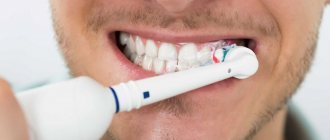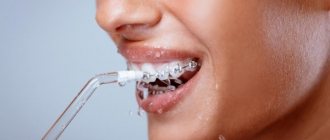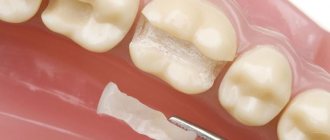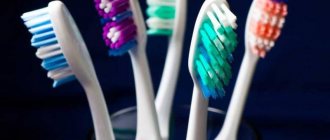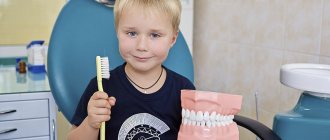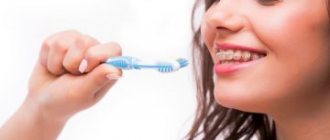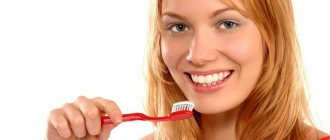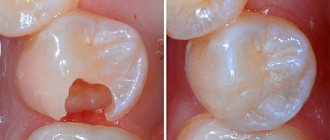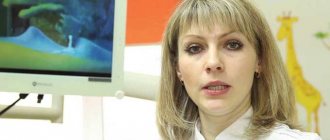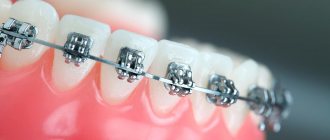The key to complete cleansing of the oral cavity is a properly selected toothbrush. Today, this dental care device is constantly being improved, and a large number of new models are appearing. Consumers are faced with the question: which toothbrush is better, electric or regular? This needs to be dealt with in more detail, taking into account all the positive and negative aspects of the devices.
Which toothbrush is better to buy - electric or regular?
Today, toothbrushes come in a variety of types, models and shapes, so the question arises about which toothbrush is better - an electric or a regular one. To choose the right hygiene item, it is necessary to take into account both the principles that it must comply with and the properties of the product. When purchasing a device, you should remember the individual characteristics of the structure of the oral cavity, the condition of the gums and enamel.
Functional purpose
Toothbrushes are not only a hygiene item for healthy teeth, but also act as an auxiliary element in the treatment and prevention of various pathological conditions. The following functional types of toothbrushes exist:
- Hygienic brushes recommended for daily use, daily cleaning of the oral cavity from food debris, bacteria and plaque.
- Preventive toothbrushes with soft bristles, which are used for hygiene by patients with periodontitis after surgery.
- Toothbrushes for special purposes, which have a special specific arrangement of bristles. Such instruments are used by patients when installing braces or orthodontic structures.
Types of Electric Toothbrushes
The source of energy for operating electrical appliances is batteries or accumulators. According to the principle of operation, mechanical, sound and ionic models are distinguished.
Mechanical devices can be reciprocating or combined. With a reciprocating design, the brush head is capable of moving both in a circle, rotating in opposite directions, and vertically. With a combined design, additional cross bristles are installed on the head of the device, which effectively clean areas that are inaccessible to a regular brush.
Electric brushes using sound technology are equipped with a special generator that produces sound or ultrasonic waves. Sound vibrations soften plaque and food debris. At the same time, the bristles moving at high speed quickly clean the oral cavity.
Ultrasound, acting in a non-contact manner, destroys bacteria and removes plaque.
Ionic products use a rod coated with titanium dioxide. This material, when combined with a liquid, attracts hydrogen ions, which destroy pathogenic flora. The device is used to clean the oral cavity without the use of toothpaste.
To make the right choice, you need to know the pros and cons of an electric toothbrush.
Regular product
Today, a mechanical tool is considered a budget option.
How the movements are performed with different cleaning techniques
Its work is carried out manually by a person. Using an individual instrument, it takes a lot of time to tidy up the oral cavity, rid it of pathogenic flora and remove plaque from the teeth, thereby preventing caries.
When choosing a tool, you need to pay special attention to:
- The structure of the bristles.
- The size of the working head.
Ultrasonic and ion models
In the ultrasonic model, the movements of the bristles are ensured by the action of a piezocrystal, the charge on the faces of which leads to the appearance of internal vibrations (1.6 MHz) transmitted to the bristles. Simultaneously with mechanical cleaning of the enamel, the device acts on the teeth with ultrasound.
The difference in the degree of ultrasound absorption between bone tissue and dental plaque leads to detachment and removal of plaque.
Dental care with an ultrasonic brush has the following advantages:
- removal of dental plaque and pigmentation leads to a whitening effect;
- ultrasound has an antiseptic effect on the oral cavity;
- the medicinal components of toothpaste penetrate into tissues under the influence of ultrasound;
- The device gently cleans braces, dentures and sensitive areas.
The ion device contains a titanium dioxide rod in the handle. By creating different polarities between plaque and the surface of the teeth, the brush attracts plaque and cleanses the oral cavity of germs. Its long-term use reduces gum bleeding and enamel sensitivity.
Advantages of an electric device
The market for oral care products offers the following types of devices:
- Electric mechanical brush. This device is the most popular among consumers. It has a rounded head, the bristles are arranged in several rows. The work is carried out using circular and translational movements. Operates on batteries or a charger.
- Ultrasonic. The function is carried out by a generator that emits the corresponding frequencies. With the help of ultrasound, deposits on the surface of the dentition and in the interdental space are broken down. Operates on batteries or rechargeable batteries.
- Sound. They operate via a sound generator. Microbes are removed and food debris is removed.
Each type of electric toothbrush has its own advantages. Therefore, when choosing an electric or ultrasonic brush, you need to familiarize yourself with the positive aspects of these devices.
The advantages of a mechanical electric toothbrush include:
- gentle cleansing of the oral cavity and dentition;
- the ability to remove germs and contaminants even in hard-to-reach areas of the oral cavity;
- effective removal of harmful bacteria;
- no negative impact on the enamel surface;
- improving the appearance of the dentition even after several hygiene procedures;
- cleaning time is halved;
- opportunity to save toothpaste.
The device should not be used if there is bleeding gums, inflammatory processes, increased sensitivity of chewing units, or tooth mobility. When choosing which brush is better, regular or electric, you should also take into account the presence of contraindications for use.
The main advantages of sound devices include:
- effective cleansing of the oral cavity;
- excellent removal of soft plaque;
- prevention of the appearance of soft and hard deposits;
- no special skills are needed to carry out the hygiene procedure;
- Many models have sound sensors that regulate the time of influence on the upper and lower dentition. Thanks to this, the procedure will be most effective;
- no trauma to the soft tissues of the oral cavity.
Before choosing whether to choose an electric or sonic toothbrush, you should familiarize yourself with the advantages of these devices.
The advantages of ultrasonic electrical products include:
- they have the best cleaning effect due to ultrasonic radiation;
- it is possible to choose the speed;
- time for performing a hygienic procedure is saved (this makes the devices different from manual ones);
- You can save toothpaste compared to a regular brush;
- An ultrasonic toothbrush helps improve microcirculation of blood fluid;
- This product helps to quickly clean teeth and remove plaque;
- Can be used for sensitive teeth;
- prevention of the proliferation of pathogenic microorganisms;
- with the help of an ultrasonic product it is possible to clean dental structures - braces, dentures, implants;
- Most models are equipped with a comfortable handle and an oval head that does not injure the tissues of the oral cavity.
How to use a fancy brush correctly
To maintain the electric brush in working condition, it is necessary to change the batteries or charge the battery on time. To avoid damaging the enamel, do not apply increased pressure during the cleaning process. Before cleaning, the bristles of the electric brush are moistened with water, and toothpaste is applied in a small amount (about the size of a pea).
To properly brush your teeth with an electric brush, you must follow these rules:
- When cleaning the side surfaces of the teeth from the outside and inside, hold the product at an angle of 45° and slowly move the cleaning head in one direction, pausing for 2 seconds on each tooth.
- When cleaning the front surface of the teeth, the device is held vertically.
- The chewing surface of the teeth is cleaned with the brush in a horizontal position.
The ionic brush provides a cleaning effect due to the ionic process and allows you to do without toothpaste. After moistening the bristles with water, use the ionic device to brush your teeth like a traditional brush, spending 2-3 minutes on the process.
Contraindications
Electric toothbrushes, the pros and cons of which you should know, have a number of contraindications for use. You should not use an electric brush if you have the following oral diseases:
- caries;
- hypoplasia and aplasia of enamel;
- gingivitis and stomatitis;
- receding gums;
- tooth mobility;
- periodontal disease;
- neoplasms.
When the ionic brush operates, an ionic flow is created. Therefore, people who smoke and have problems with the oral mucosa should use the device with caution, because galvanic currents produced by the device irritate the mucous membranes and aggravate the negative effects of nicotine. If you suspect oral diseases, consult a dentist.
Advantages and disadvantages
Let's find out why an electric toothbrush is still better than a conventional design:
- The quality of cleaning tooth enamel and treating the oral cavity increases several times.
- Using an electric tool makes it possible to quickly remove pigmentation from coffee, tobacco and wine.
- Dental deposits are removed: small stones.
- Preventive actions, treatment of gums, gingivitis, reduction of periodontal pockets.
- The versatility of the device is manifested in the careful treatment of the surface of the teeth, tongue and oral cavity as a whole.
- Blood circulation improves, which helps strengthen gums.
- You can change the pressure on the tool and adjust it.
- Use toothpaste with a lower abrasive coefficient, thereby reducing the cost of purchasing it.
Unfortunately, not everyone who wants to can use the electric version of the product.
According to practicing dentists and specialists, it is not recommended to use an electrical device:
- Dentists do not recommend using electric brushes during pregnancy.
- Children up to a certain age.
- People who have had a stroke or heart attack and have a pacemaker.
Brushes for children
The toothbrush should be age appropriate and have an attractive design. To ensure that the child enjoys the cleaning process, select a product whose head and handle have a comfortable shape and suitable size. For children under 2 years old, it is better to choose a brush with silicone bristles, a rubberized head (1.5 cm in size) and a handle up to 10 cm long. For children under 5 years old, a brush with soft bristles is suitable, with a head size up to 2 cm, and handles up to 17 cm long. cm.
Read also: When does a child lose teeth?
Children can use an electric brush from 3 years old. It removes plaque well and protects the enamel from caries. A child's version of a classic electric brush of a reciprocating or combined type with soft and low bristles will be suitable.
The batteries powering the device are protected by a waterproof case, so the electrical device is safe for children. To make sure that the device is suitable for your child, you should visit your pediatric dentist before purchasing an electric toothbrush. The child must be taught to use a brush, and he must brush his teeth under adult supervision.
What is the difference between an electric toothbrush and a regular toothbrush?
In the market of the electric brushes
are divided into two types: rechargeable and battery-powered. The first type of teeth cleaning device operates from a power outlet and requires replacing the brush head quarterly. Models of this type differ in cleaning technology, which can be sonic, with a 3D cleaning effect, and reciprocating rotation.
A battery-powered toothbrush differs from the previous version in that it produces additional vibrations that help clean teeth more thoroughly.
Traditional or electric brush: what to choose?
For example, Braun toothbrushes
Thanks to its high-oscillation operation, it removes significantly more plaque, which reduces gum problems much better than using a traditional toothbrush.
A regular toothbrush, which everyone is used to, has a plastic handle. Its nylon heads come in a variety of shapes and designs. This is the most common type of device for maintaining oral hygiene procedures. No power supplies are required here.
Which models are the best?
If the question of which toothbrush is better - a regular or an electric one - has been resolved, then you need to choose the best model. When choosing a traditional brush, models with the following parameters are suitable:
- polymer bristles with antistatic properties,
- rounded top;
- silicone inserts on the handle;
- flexible connection between handle and head.
You should choose products with bristles whose degree of rigidity corresponds to the condition of the gums and teeth. The best option for an electric brush would be a product with a powerful battery that has replaceable attachments. The most popular models for both children and adults are products under the Oral B and Braun brands.
Heads for electric toothbrushes
If you regularly change heads, the electric brush will last a long time, and special types of attachments increase cleaning efficiency. Working nozzles use the following operating modes:
- 1D technology - movement occurs in a circle in one direction;
- 2D mode - circular motion is performed in the forward and reverse directions;
- When working using 3D technology, circular and pulsating movements are combined.
The attachments included with electric brushes have different cleaning properties and effects. They perform operations such as polishing, whitening, massage, cleaning sensitive teeth, double brushing, removing hard plaque, and cleaning teeth with braces.
How to care for your device
In order for the electric brush to serve for a long time and provide high-quality teeth cleaning, you should follow the rules for caring for the device:
- Before and after cleaning, rinse the nozzle under running water;
- dry the device only in a vertical position;
- change the nozzle every 3-4 months;
- store the product in a clean, dry stand;
- Check the battery charge periodically.
Before choosing an electric toothbrush, you should evaluate your oral health to determine the appropriate type and model of device. An individually selected device will make the cleaning procedure convenient and maintain dental health.
Which toothbrush is better, electric or regular?
To care for the oral cavity, you need special devices. The right toothbrush will help remove plaque and tartar, lighten the enamel and prevent the occurrence of caries.
There is a wide range of such products available on the market. They are all different:
Therefore, users may often have a question: Which brush is better to choose - regular or electric? When choosing, you should focus not only on the principle of operation of the device, but also on its properties.
It is necessary to take into account the characteristics of the oral cavity, enamel and gums of each person, since these factors are individual.
When is a regular device better?
The manual model differs from the electric model in many respects. The main difference between the chosen device is the need to perform the movements independently. According to most dentists, the best device for every person is the one with which a person can perform personal hygiene twice a day. The duration of the procedure should be at least 2 minutes. If you brush your teeth and gums correctly, there is not much difference between an electric brush and a mechanical one.
Advantages of a conventional device:
- affordable price;
- compactness and lightness;
- large range of designs;
- the presence of a scraper for cleaning the surface of the tongue.
The disadvantages include:
- the need for control during the hygiene procedure;
- the requirement to make efforts to provide better quality care.
The advantages of electrical means include:
- comfortable handle;
- indicator notifying the completion of the procedure;
- better care, removal of germs and food particles in hard-to-reach areas;
- Even distribution of toothpaste.
Minuses:
- increased price;
- the need to charge battery devices or change batteries.
A round electric toothbrush is good for those consumers who have difficulty using a mechanical model. This product can be especially convenient for people with disabilities. Currently, it is possible to purchase an electric model for children that plays music and sings songs while the child brushes his teeth. For children, such cleansing turns into a game. In addition, cleaning devices take better care of your oral cavity.
It is better to purchase electrical products for users who suffer from arthritis or those who have difficulty using a manual device. According to most dentists, it is better to refrain from purchasing such a product for those who have undergone surgery in the oral cavity, especially those who have been treated for cancer. With such a difference between the models, it is better to choose a conventional device.
Electrical means
Today, most people prefer to use electrical devices that can be powered by mains or batteries. Dentists also recommend using such products, since with their help you can thoroughly clean all places in the mouth that are difficult to access.
- You can change the nozzles.
- Does not have a negative effect on the gums.
- Cleans enamel well.
- Massages the gums and prevents their inflammation.
- You can clean your tongue.
- Durability.
- The cleaning procedure itself is pleasant.
Sometimes an electrical device can clean by using sound waves. They are divided into:
In the first case, a piezoelectric crystal is used for cleaning, which creates small vibrations of the pile. This helps to clean teeth efficiently and quickly from even the smallest particles of food and plaque. Such devices help whiten enamel, destroy microbes in the mouth, and the paste penetrates the enamel structure.
Ionic devices contain titanium dioxide in the handle. With its help, polarity is created between plaque and the tooth, which allows it to be better cleaned. With constant use of the device, the condition of the gums improves and the sensitivity of the enamel decreases.
Contraindications
In addition to their advantages, brushes have contraindications, in the presence of which their use should be abandoned. You should refrain from using them if you have the following diseases:
- Enamel aplasia.
- Caries.
- Stomatitis.
- Tooth mobility.
- Recessed gums.
- Neoplasms in the mouth.
- Periodontal disease.
Read also: Teeth grinding at night
Those who smoke should treat such devices with caution; they can irritate the mucous membranes in the mouth, increasing the negative effects of nicotine.
Features of a simple brush
Using a regular brush, teeth are mechanically cleaned from food debris and plaque. It can have bristles of different hardness: very soft (for children), soft (for pregnant and lactating women), medium hard (for everyone), hard (for smokers and coffee lovers) and very hard (for cleaning dentures). Even the toughest models are not able to remove deep plaque and deposits from teeth and gums.
Simple brushes should be used in conjunction with dental floss to effectively clean the interdental spaces. This is the main drawback of standard toothbrushes, even the most advanced ones. But they also have advantages:
- low price;
- variety of models;
- safety and ease of use.
There are times when it is better to use a manual brush rather than an electric one. Let's list them.
Regular brush
The use of the products is widespread. It has characteristics, the main one of which is the hardness of the pile. Those who have a lot of plaque on their teeth should give preference to a product with hard bristles. But it must be applied carefully so as not to damage the enamel.
Typically, brushes with medium bristles are used. They are often used by people with healthy teeth and gums.
Such devices can also differ in the number of beams and shape. All these points affect the quality of cleaning. Based on these characteristics, brushes are also divided into:
- Preventive. Can be bought at any store. They have piles of different lengths and hardness.
- Hygienic. The length of the beams and their rigidity are the same. Usually intended for children.
- Special. Can be used for cleaning briquettes or implants. Sold in pharmacies.
The use of conventional devices should also be abandoned in the following cases:
- Thin enamel that can be damaged even by soft bristles.
- Inflammation of the gums.
Number of rows and nature of bristle arrangement
The functionality and hygienic properties of toothbrushes are ensured by the specific arrangement of the bristles. Accordingly, there are the following groups of hygiene instruments:
- One block of bristles is typical for brushes that are used in the presence of orthodontic or orthopedic structures.
- Two rows of fibers form a hollow groove between themselves. This design is suitable as a hygienic means when using a braces system.
- Three rows of bristles – a brush with bristles arranged in three longitudinal rows provides gentle cleansing and prevents damage to gums and soft tissue.
- Four rows of fibers is the most common bristle pattern. This model of toothbrush is optimal and is often recommended by dentists for patients with healthy teeth.
What to choose?
Dentists say that this question cannot be answered with certainty. Here it is worth taking into account the characteristics of each person and his oral cavity. The best brush is the one you use all the time. It doesn’t matter which manufacturer or the presence of any special features. The main thing is that it suits the person.
The device may be expensive and meet all the requirements. But if a certain person has certain diseases in the oral cavity, it is impossible to use a product intended for a healthy oral cavity. For example, when your gums bleed.
How to choose?
When choosing a device, dentists recommend paying attention to certain points and following certain rules. This:
- Bristle material. Dentists recommend using brushes with artificial bristles, as water does not accumulate on them, where microbes can multiply.
- Head size and shape. It all depends on the characteristics of the person and his age. Typically, brushes are used with bristles ranging from 25 to 30 mm. With the help of such bristles you can reach all places in the mouth.
- The handle should be comfortable and not slippery. It is also important to choose the right thickness so that it fits well in your hand.
- When purchasing, you need to study the information on the packaging.
- The bristles should not have sharp ends that could damage the gums.
In the dental market you can find various devices for cleaning teeth. The ranking of the most popular devices is headed by the following motels:
- Colgate. A world-famous device. Improves microflora and does not disturb the enamel structure. The product is mechanical.
- Lacalut White. It is distinguished by a unique pile that removes plaque well. There is a special pile on the side that helps whiten the enamel. Mechanical.
- Oral-B Vitality Precision Clean. An electrical device that can operate uninterruptedly on battery power for 20 hours. Dentist approved.
- Pro Gold Edition from ROCS The bristles contain pine phytoncides, which have a positive effect on the mucous membranes and gums in the mouth. Electric.
The cost of such products can vary greatly. This depends on many factors, including:
- Product type.
- Manufacturer.
- Place of sale.
- Model.
The average cost of goods in the Russian Federation ranges from 1000 rubles. up to 3000 rub.
It is important to choose the right devices and care for them.
The rules of care are:
- This is an individual remedy and should not be given for use by others. In this case, the product will become a carrier of infection.
- Storage rules are also important. After cleaning, wash the bristles and place the brush vertically, head up. For storage, use a regular glass or a special holder.
- You cannot store the device in a closed case, as it will not be able to dry out there. This will create an environment for bacteria to multiply. You can put it in the case when it dries.
- It is worth changing the product once every 3 months if it has not worn out before. This applies to all types of products.
- When the bristles are damaged, you should not use such a device as it will damage your gums.
It is also recommended that when choosing a brush of one type or another, consult your doctor first.
He will make a recommendation based on the individual characteristics of the patient’s oral cavity.
- Georgy. 30 years. A product for cleaning teeth, in my opinion, should be practical and inexpensive. It's not a pity to break it. Also, in practice, I have noticed that an expensive device is not always of high quality. Initially I used conventional devices, but recently I prefer electric ones.
- Hope. 27 years. For me, the best option is a regular brush, which I choose after consulting with a dentist. I often use medium soft products because my gums bleed. I also don’t see the point in paying more for an electrical mechanism that may be of poor quality and quickly break down.
- Svetlana. 25 years. I prefer only electric brushes. Ordinary ones cannot be used. I often changed the usual devices before, as they caused blood flow from the gums, even the softest ones. Therefore, I decided, in order not to constantly buy such products, it is better to buy a high-quality electric one, and then only change the attachments on it. I'm happy with my decision. I don't regret it. My enamel is always white, even after coffee.
Read also: How to reduce tooth sensitivity
Is this justified?
To date, many different, but similar in essence, studies have been carried out. The effectiveness of individual oral hygiene using a regular manual toothbrush is lower than when using an electric one. But, nevertheless, after learning the correct technique from a dentist, a higher quality effect is achieved than simply from an electric one.
Based on a brief description of the research results, it is clear that the key factor is not the brush, but the ability to use it. It is not difficult to obtain the necessary skills; they are understandable to everyone, intuitively.
Next, we will offer several methods of oral care.
How to brush your teeth correctly
Standard method
The dentition is divided into 6 parts: molars on the left, right and front teeth on the upper and lower jaws.
- The teeth of the upper and lower jaws should not be connected. When cleaning them, the brush is positioned at an angle of approximately 45 degrees to the surface of the tooth.
- They begin to clean from the buccal surface of the upper jaw on the left, where they make about ten sweeping movements with the brush, then in the same way, clean the remaining teeth (about ten movements on each part).
- After this, the palatal surface of the upper teeth is cleaned according to the same pattern.
- The next step is to clean the chewing surface of the molars. This is a classic of the genre. We place the brush with the bristles towards the teeth and clean this surface with reciprocating movements. You need to make 10-15 movements on each side.
- On the lower jaw, hygiene is carried out in the same sequence, in a similar way.
- We massage the gums and clean the tongue.
Pattern of movement of a toothbrush in the oral cavity
Leonard method
The same standard method, but we perform the sweeping movements with the jaws closed. From the inner surface, of course, you will have to open your mouth. This method is more gentle on the gums.
Bass method
We position the brush at an angle of 45 degrees to the surface of the tooth, and make vibrating movements without moving the ends of the bristles. The chewing surfaces are cared for as with the standard method.
This method allows you to thoroughly clean the cervical area of the molars.
Ideally, it is necessary to combine these methods, alternate the pastes used, use dental floss, rinses and other means to get closer to the ideal state of the oral cavity. Even by performing some of the listed remedies, we will already significantly improve our health.
As you can see, there are many methods of brushing teeth, and, of course, this is not all.
What to look for when choosing an electric toothbrush
- Build quality. It should not crunch or creak in your hands.
- Ergonomics. The device should be convenient for you.
- Rigidity.
- Quality of teeth cleaning. After the procedure, you should have a clean mouth.
- Availability of several driving modes.
- Reasonable price.
A battery-powered toothbrush has some disadvantages:
- Price. You have to pay for comfort and modernity.
- The need to recharge or replace batteries.
Electric brush: cons
The main disadvantage of electric brushes is the high price of the device itself and removable attachments. There are other disadvantages:
- Presence of contraindications: many fillings, enamel wear, heart disease, etc. Before purchasing, you need to visit a dentist.
- The need to recharge (if the device is battery operated) or replace batteries.
- Not suitable for children under 3 years of age.
Before purchasing such a device, you need to see a dentist. Perhaps the results of the examination will show that a regular toothbrush is better than an electric one.
